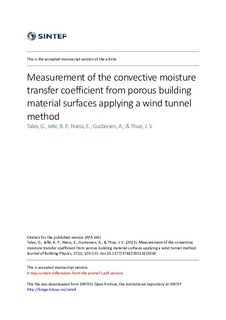| dc.contributor.author | Talev, Goce | |
| dc.contributor.author | Jelle, Bjørn Petter | |
| dc.contributor.author | Næss, Erling | |
| dc.contributor.author | Gustavsen, Arild | |
| dc.contributor.author | Thue, Jan Vincent | |
| dc.date.accessioned | 2017-12-28T21:35:13Z | |
| dc.date.available | 2017-12-28T21:35:13Z | |
| dc.date.created | 2012-09-07T19:09:55Z | |
| dc.date.issued | 2013 | |
| dc.identifier.citation | Journal of Building Physics. 2013, 37 (1), 103-121. | nb_NO |
| dc.identifier.issn | 1744-2591 | |
| dc.identifier.uri | http://hdl.handle.net/11250/2473839 | |
| dc.description.abstract | This article presents results for the average convective moisture transfer coefficients of several porous building material samples exposed to airflow. The experimental measurements explore the effect of the various air velocities, air temperatures and local positions on the average convective moisture transfer coefficients. Selected building materials were soaked in distilled water at least 2 weeks before the measurements. A thin building specimen with moisture content close to the saturation point was mounted in level with the bottom wind tunnel surface. A stable airflow regime was measured over the thin samples placed in the specimen holder. Water from the sample holder was absorbed from the bottom side of the building materials and evaporated from the upper side of the specimen during the airflow exposure. Two different membranes were fixed over the water cup as reference materials for comparison. The measurements were carried out at a relative humidity of 50% ± 3%, air temperatures of 23.6°C ± 0.5°C, 26.5°C ± 0.5°C and 30.0°C ± 0.5°C, and air velocities of 1.1, 3.0 and 5.5 m/s. The experimental data show that the convective moisture transfer coefficient is a function of velocity, temperature difference between the ambient air and material surface, local position as well as of the material type. The experimental results from water surfaces were compared to the expressions for the convective moisture transfer coefficients from the literature. | nb_NO |
| dc.description.sponsorship | ACKNOWLEDGMENTS. The authors gratefully acknowledge Ole Aunrønning who provided practical support during various experimental work tasks. | nb_NO |
| dc.language.iso | eng | nb_NO |
| dc.publisher | Sage | nb_NO |
| dc.subject | Convective moisture transfer coefficient | nb_NO |
| dc.subject | Porous | nb_NO |
| dc.subject | Buildings | nb_NO |
| dc.subject | Surface | nb_NO |
| dc.subject | Wind tunnel | nb_NO |
| dc.title | Measurement of the convective moisture transfer coefficient from porous building material surfaces applying a wind tunnel method | nb_NO |
| dc.type | Journal article | nb_NO |
| dc.type | Peer reviewed | nb_NO |
| dc.description.version | acceptedVersion | nb_NO |
| dc.rights.holder | © 2012 Sage. All rights reserved. This is the authors' accepted and refereed manuscript to the article, post-print. Released with a Creative Commons Attribution Non-Commercial No Derivatives License. The final publication is available at https://doi.org/10.1177/1744259112459262 | nb_NO |
| dc.subject.nsi | VDP::Technology: 500 | nb_NO |
| dc.source.pagenumber | 103-121 | nb_NO |
| dc.source.volume | 37 | nb_NO |
| dc.source.journal | Journal of Building Physics | nb_NO |
| dc.source.issue | 1 | nb_NO |
| dc.identifier.doi | 10.1177/1744259112459262 | |
| dc.identifier.cristin | 943074 | |
| cristin.unitcode | 7401,30,40,0 | |
| cristin.unitname | Arkitektur, byggematerialer og konstruksjoner | |
| cristin.ispublished | true | |
| cristin.fulltext | original | |
| cristin.fulltext | postprint | |
| cristin.qualitycode | 2 | |
